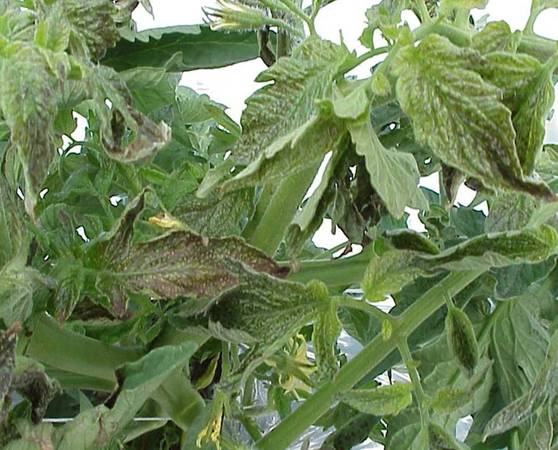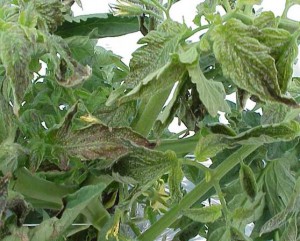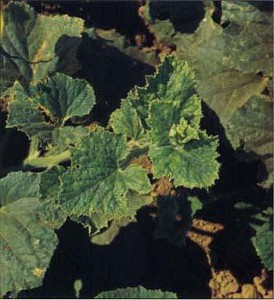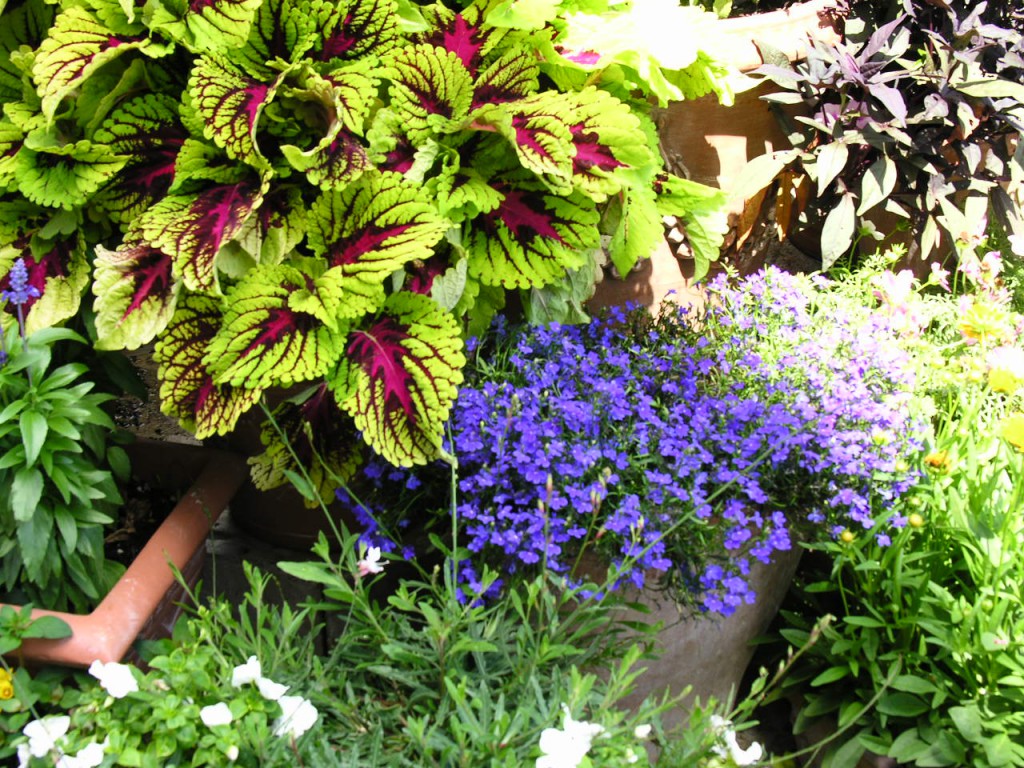
by Eddie Powell | Jun 3, 2014
During this growing season monitor your plants and keep them healthy as a healthy plant will be able to better survive an invader attack.
Nematode populations can be reduced temporarily by soil solarization. It is a technique that uses the sun’s heat to kill the soil-borne pests. Adding organic matter to the soil will help reduce nematode populations as well. Nematodes are microscopic worms that attack vegetable roots and reduce growth and yield. The organic matter will also improve water holding capacity and increase nutrient content.

Tomato Spotted Wilt Virus
Credits: UF/IFAS
If you choose to use pesticides, please follow pesticide label directions carefully. Learn to properly identify garden pests and use chemicals only when a serious pest problem exists. If you have questions please call your UF/IFAS county extension office. We can provide helpful information about insect identification.
Organic gardeners can use certain products like BT(Dipel) to control pests. Please remember not every off-the-shelf pesticide can be used on every crop. So be sure the vegetable you want to treat is on the label before purchasing the product.
Follow label directions for measuring, mixing and pay attention to any pre-harvest interval warning. That is the time that must elapse between application of the pesticide and harvest. For example, broccoli sprayed with carbaryl (Sevin) should not be harvested for two weeks.
Spray the plant thoroughly, covering both the upper and lower leaf surfaces. Do not apply pesticides on windy days. Follow all safety precautions on the label, keep others and pets out of the area until sprays have dried. Apply insecticides late in the afternoon or in the early evening when bees and other pollinators are less active. Products like malathion, carbaryl and pyrethroids are especially harmful to bees.
To reduce spray burn, make sure the plants are not under moisture stress. Water if necessary and let leaves dry before spraying. Avoid using soaps and oils when the weather is very hot, because this can cause leaf burn.
Control slugs with products containing iron phosphate.

Cucumber Mosaic Virus
Credits: UF/IFAS
Many common diseases can be controlled with sprays like chlorothalonil, maneb, or mancozeb fungicide. Powdery mildews can be controlled with triadimefon, myclobutanil, sulfur, or horticultural oils. Rust can be controlled with sulfur, propiconazole, ortebuconazole. Sprays are generally more effective than dusts.

by Taylor Vandiver | Jun 3, 2014
In a world of limited time and space, container gardens seem to make more and more sense. Poor soil and no place to put plants in the ground are no longer good excuses for not being able to enjoy the simple pleasures of gardening. Container gardening allows the individual to create gardens to fit any situation. Gardening in containers can be just as rewarding as having a full-size garden.
There are a few items to consider when you are planning your container garden. The first is the plants you intend to use. If you are planting more than one plant in the same pot be sure that all your plants meet the same requirements. The requirements you should consider are amount of light, amount of water, climate and fertilizing needs. Some other things you might want to think about when planning your container garden are height, color, and texture. A nice variation of these elements will make your container gardens more attractive and increasingly more interesting to look at.
The next step in container gardening is choosing your container. A good rule of thumb is: “Anything that holds soil and has drainage holes in the bottom may be transformed into a container garden.” It can be a pot you purchased from the local gardening center or an old bathtub you picked up off the side of the road. However, be sure that the size of the container matches the current and potential size of your plant. For vibrant plant growth, the containers must provide adequate space for roots and soil media, allowing the plant to thrive.

Colorful containers bring life to your small spaces.
Next on your list is choosing a soil for your container. Container soils need have good aeration and decent drainage, while still being able to retain enough moisture and nutrients for plant growth. When choosing what to use in containers, never use garden soil by itself. When garden soil is added to a container, both drainage and aeration are severely impeded, and the results are plants that grow poorly or not at all.
Container soils are often referred to as soilless or artificial media, because they literally contain no soil. They are commonly composed of various media such as peat moss, perlite, vermiculite, bark and coir fiber (ground coconut hulls) in a variety of mixes. When using soilless media remember t0 moisten it slightly before planting. Fill a tub with the media, add water and lightly fluff the media to dampen it. This will keep the mixture from becoming hydrophobic (unable to take up water) throughout its life in the container. When adding media to your containers, never fill the pot to the top. You should leave about a one-inch space between the top of the soil and rim of the pot. This will make watering the pot easier as it provides a place to “put water” and not have it run over the edge.
When watering your container gardens, the best time to do so is in the morning. Watering in the morning allows the leaves of your plants and soil to dry out, preventing diseases and viruses. Remember that overwatering is the most common reason for fatalities in container gardens. Check your soil by pushing your finger into the media; if the media is moist don’t water it. When it comes to fertilizing your container gardens, fertilize only as needed. Over-fertilization will result in a buildup of salts and may burn the roots of your plants. Try to fertilize your plants during the growing season, and only if needed during the dormant seasons.
The most important objective when container gardening is to be creative. Maybe, try a variety of plants in one container garden. While an nicely put together individual container can be quite impressive, think what might happen if you put several containers together in a group. Also, don’t limit your container gardens to flowers–many vegetables can be grown in a container and actually do quite well. There really is no limit to what can be done in a container!





